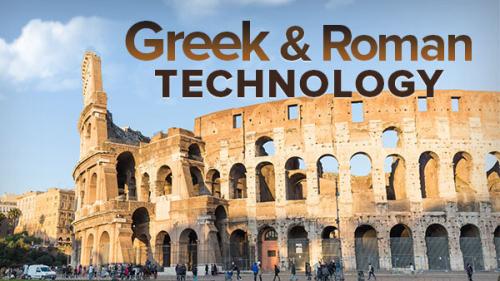TheGreatCoursesPlus - Understanding Greek and Roman Technology
Expand your knowledge of Greek and Roman civilization with this in-depth study of their innovative technologies and feats of engineering.
1: Technology in the Classical World
- Begin your exploration of ancient Greek and Roman engineering by probing the technological edge that allowed the Greeks to beat the Persians at the Battle of Salamis. Then survey the aims of the course and preview an impressive piece of technology that you will encounter in a later lecture.
2: The Substance of Technology-Materials
- Study the engineering materials available in classical antiquity. First look at the simple physics of compression and tension. Then consider six specific materials: stone, wood, clay, copper, bronze, and iron. Examine how they came into use and how their properties influenced the design of technological systems.
3: From Quarry to Temple-Building in Stone
- Gain a deeper appreciation for the ancient world's most important construction material by following a block of stone from a quarry to its final resting place in the wall of a Greek temple. Learn how stone blocks were extracted from solid bedrock, moved many miles, and then fitted together without mortar.
4: Stone Masonry Perfected-The Greek Temple
- Focus on the classical-era temple, one of the crowning achievements of Hellenic civilization. Where did it originate? Why are the many examples so architecturally consistent? What were the principles of Greek temple design? And what were its structural limitations?
5: From Temple to Basilica-Timber Roof Systems
- No wooden roof of a Greek temple has survived from antiquity, yet we can surmise a great deal about how these impressive structures were engineered. Trace how Greek and later Roman architects covered large interior spaces with increasingly sophisticated timber roof systems.
6: Construction Revolution-Arches and Concrete
- Learn how the physics of the arch solves the problem of the tensile weakness of stone. Then see how standard bricks and concrete greatly simplify and reduce the cost of monumental building. These technologies were the key to Rome's construction revolution.
7: Construction in Transition-The Colosseum
- Built in the A.D. 70s, the Colosseum reflects a transitional period of Roman building technology. Follow the construction of this mammoth arena from the ground up. Begin with the geometry of the building. Then focus on its blend of traditional and state-of-the-art construction techniques.
8: The Genesis of a New Imperial Architecture
- Focus on two structures-Nero's Golden House and Trajan's Market-which are emblematic of Rome's bold new imperial architecture during the 1st and early 2nd centuries. These buildings feature complex vaulted and domed structures, asymmetrical floor plans, and striking interior spaces.
9: The Most Celebrated Edifice-The Pantheon
- Conclude your study of great classical-era structures by examining the greatest of them all: the Pantheon in Rome. Imitated but never equaled, this temple to all the gods incorporates Greek as well as quintessentially Roman architectural features. The stupendous dome is a work of engineering genius.
10: Cities by Design-The Rise of Urban Planning
- Start a series of lectures on infrastructure in the classical world with a look at city planning. The Piraeus in Greece was an influential early example. Analyze the Roman approach to creating a rational order for their cities. Also learn the Roman technique for surveying a city plan.
11: Connecting the Empire-Roads and Bridges
- At its height, the Roman Empire had 75,000 miles of public roads, organized into a system that incorporated way-stations, milestones, triumphal arches, and upward of 1,000 bridges. Investigate how the Romans created this impressive transportation network, parts of which have survived for 2,000 years.
12: From Source to City-Water Supply Systems
- Delve into the history of water supply technologies. The Greeks solved the problem of transporting water across deep valleys by building inverted siphons. By contrast, the Romans preferred to use arcaded aqueduct bridges whenever possible. Why was this apparently extravagant technique often more practical?
13: Engineering a Roman Aqueduct
- Design an aqueduct for a hypothetical Roman town. First identify a water source. Then consider its elevation and distance to the town, the possible terrain profiles for a channel, and the appropriate type of aqueduct. Conclude by examining the complex system that supplied plentiful water to Rome.
14: Go with the Flow-Urban Water Distribution
- Trace the flow of water through a major city such as Rome-from the aqueduct to water towers, public fountains, buildings and private residences, and ultimately to sewers. Among the questions you consider: Did the widespread use of lead pipes create a lead poisoning hazard?
15: Paradigm and Paragon-Imperial Roman Baths
- Complete your exploration of classical-era infrastructure by exploring one of the ancient world's finest examples of an engineered system: the imperial Roman baths. Focus on the magnificent Baths of Caracalla, finished in A.D. 235, by spotlighting the major steps in its five-year construction.
16: Harnessing Animal Power-Land Transportation
- Begin a sequence of eight lectures on machines in the ancient world. After an introduction to the simple machines described by the Greeks, focus on land transport employing the wheel and axle. Discover that wagon technology reached a high level of sophistication in the Roman Empire.
17: Leveraging Human Power-Construction Cranes
- How were giant stone blocks lifted using only muscle power? Examine the technology of classical-era cranes, breaking down their components to understand how they provided significant mechanical advantage. Close with a theory on the construction technique used to stack the massive marble drums of Trajan's Column in Rome.
18: Lifting Water with Human Power
- In antiquity, water pumps were extensively used in ships, mines, and agriculture. Investigate how these devices worked. From Archimedes' screw, to the waterwheel, to the piston pump, each had tradeoffs between flow rate, height of lift, and muscle power required.
19: Milling Grain with Water Power
- By the 1st century A.D., waterwheels were widely used for grinding grain throughout the ancient world. Explore three different types of waterwheels that were perfected by the Romans: the undershot wheel, the overshot wheel, and the vertical-shaft wheel, each with its advantages and disadvantages.
20: Machines at War-Siege Towers and Rams
- Focus on the ancient world's most technologically intensive form of warfare-the siege-which provided a powerful stimulus for the development of large-scale machines such as siege towers and rams. Analyze several famous sieges, including the Roman attack on Jotapata during the Jewish War.
21: Machines at War-Evolution of the Catapult
- Trace the evolution of the catapult, which overcomes the inherent human physiological limitations associated with the bow and arrow. From hand-operated crossbows, catapults progressed to giant artillery pieces able to shoot enormous arrows and hurl heavy projectiles. Revisit a type of catapult called the palintone from Lecture 1, and watch it in action.
22: Machines at Sea-Ancient Ships
- Spurred by their dependence on maritime trade, the ancient Greeks became masters of nautical engineering. Follow the development of their ship design and sailing techniques, which were adopted by the Romans and paved the way for the great age of exploration in the 15th century.
23: Reconstructing the Greek Trireme
- The trireme, a swift warship with three banks of oars, ruled the Mediterranean Sea in the 5th century B.C., when the Athenian empire was at its height. Yet only sparse evidence remains for what these vessels were like. Follow a detailed reconstruction based on tantalizing clues.
24: The Modern Legacy of Ancient Technology
- Finish the course by exploring the legacy of classical-era technology, discovering that its influence is everywhere. From roads, aqueducts, and planned cities, to structural trusses, concrete, and the classical architectural style, the fruits of Greek and Roman engineering play a vital role in the modern world.

Understanding.Greek.and.Roman.Technology.part1.GC.rar
Understanding.Greek.and.Roman.Technology.part2.GC.rar
Understanding.Greek.and.Roman.Technology.part3.GC.rar

































